How To Create A Shell Script In Windows
Shell is an interface of the operating system. Information technology accepts commands from users and interprets them to the operating system. If you desire to run a bunch of commands together, yous can do and so past creating a shell script. Shell scripts are very useful if you need to practice a task routinely, like taking a backup. You can listing those commands and execute them all with only a single script. Permit'southward see how you tin create a shell script and run it on Linux.
Creating a Shell Script
Login to your Linux car and open the concluding, navigate to the folder where yous want to shop the shell script. Trounce scripts end with the extension ".sh". Permit's create our kickoff beat out script. Blazon in
touch script.sh
Now, this script file is not executable by default, nosotros take to requite the executable permission to this file. Type in
chmod +x script.sh
Now, we will add some commands to this shell script. Open this beat script with whatever text editor of your choice (command-line based or GUI based) and add together some commands. We volition use nano. Type in
nano script.sh
Add the following commands to test this crush script
echo This is my offset shell script touch testfile ls echo End of my crush script
Save the changes, and run the beat out script by typing in
./script.sh
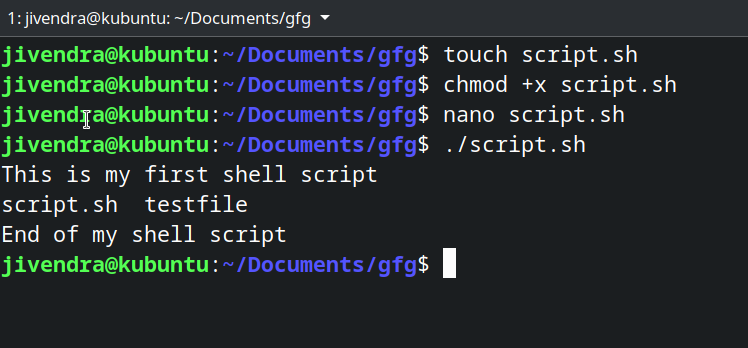
Screenshot of higher up steps
Yous can run into, it executed all the specified commands.
Comments in the beat out script
Whatever line which starts with "#" in the beat out script is treated equally a comment and is ignored by the shell during execution, except the shebang line, which nosotros volition see later in this article. Let's see an instance. A shell script is created with the post-obit content.
# This is a comment echo Testing comments in beat out script
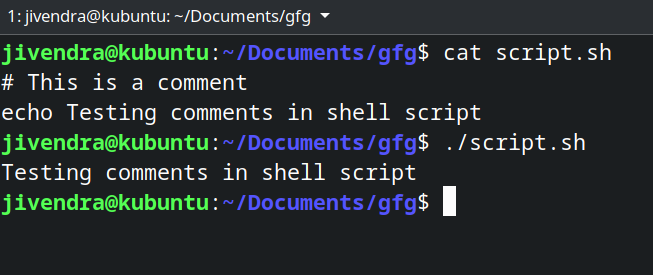
Comments in Beat out Script
Yous tin can meet, the comment gets ignored.
Variables in Shell Script
Yes, Shell scripts back up the use of variables, and we need not ascertain a variable'due south type during its declaration. There are two types of variables:
- Arrangement Defined variables
- User-Defined Variables.
Organisation-defined variables, also called surround variables, are generally Capitalised. Y'all can view all the current environment variables using the printenv control. User-Divers variables are set by the user, and they be but during script execution. You lot can define a variable by only typing its proper name and assigning a value with = sign and access a variable by adding a $ before the variable name. Variables are demonstrated in the following example script.
# Accessing an Environment Variable echo $USER # Creating and accessing User defined Variable variable_name="Geeksforgeeks" echo $variable_name
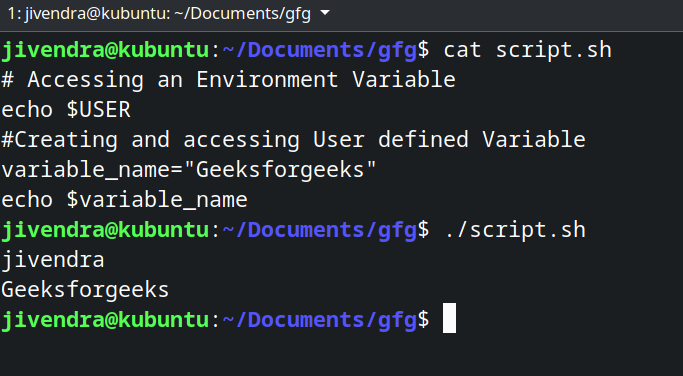
Variables in Crush Script
Defining the Shell Script interpreter
There are many Shells available in Linux, such as The bourne vanquish(sh), The Korn Shell(ksh), and GNU Bourne-Once again Trounce(bash). Scripts written for the sh crush are called shell scripts, and they can be interpreted by both, the ksh and bash shells. ksh and Bash are improved versions of the original sh vanquish and they have more features than sh. Bash is generally the default shell in most of the Linux Distributions and scripts written specifically for bash vanquish are called bash scripts.
Yous can specify which beat out the script will apply, even if the script is executed from another vanquish terminal. To exercise this, add together "#!" on top of the script file, followed by the absolute path of the vanquish of choice. To specify bash as an interpreter, Add the following line on acme of the beat out script.
#!/bin/bash
This line is chosen the shebang line.
Notation: This will just piece of work if bash is installed on your system.
Comparison Operators
You lot can compare two variables in trounce scripting. We do these comparisons to brand decisions, we volition see how to exercise that subsequently in this commodity, but before that, here is a list of some comparison operators.
Integer comparing
| Operator | Clarification |
|---|---|
| -eq | is equal to |
| -ne | is not equal to |
| -gt | is greater than |
| -ge | is greater than or equal to |
| -lt | is less than |
| -le | is less than or equal to |
String Comparison
| Operator | Description |
|---|---|
| == | is equal to |
| != | is not equal to |
| \< | is less than, in ASCII alphabetical order |
| \> | is greater than, in ASCII alphabetical order |
We add a \ before < and > considering they need to be escaped when typed in the [ ] construct. Now, let's see where these are used.
Conditional statements
Provisional statements are used to execute a block of code only when certain conditions are met. Crush scripts support the use of conditional statements. We use comparison operators to cheque the conditions. Let'southward see a few conditional statements.
If statement
It checks the condition, and if it is conditioned truthful, information technology executes the commands.
Syntax
if [ condition ] and then #statements fi
Let's see an example.
#!/bin/sh 10=10 y=11 if [ $x -ne $y ] then echo "Not equal" fi
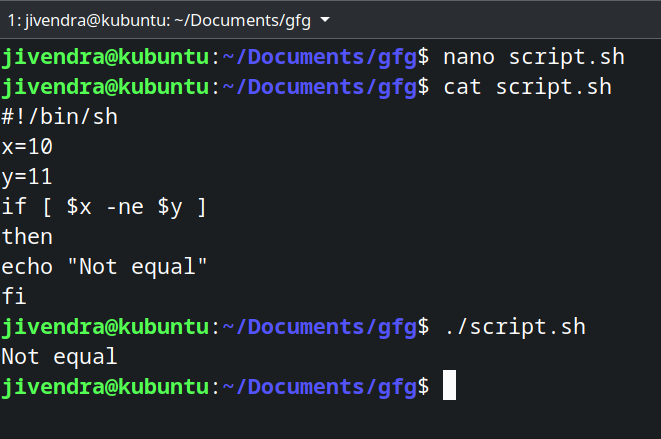
.if statement
If-else argument
In an if-else statement, yous can specify a set of commands to run if the condition is non met.
Syntax
if [ status ] then #set up of statements if the condition is true else #set of statements if the condition is false fi
Allow'due south meet an example
#!/Syntaxbin/sh 10=ten y=10 if [ $ten -ne $y ] then echo "Not equal" else repeat "They are equal" fi
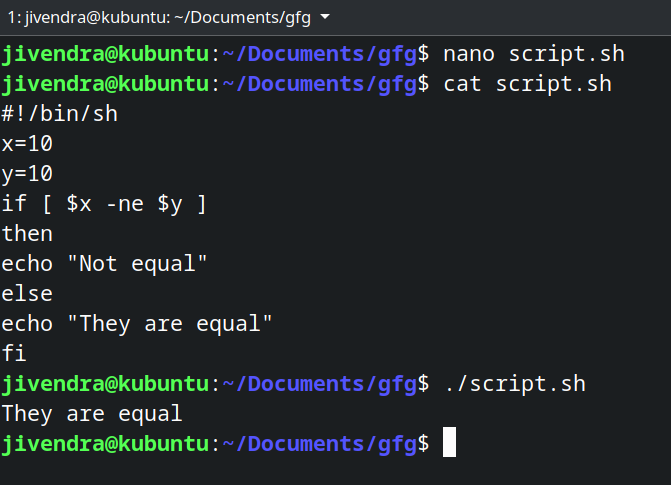
.if-else statement
There are other provisional statements, you can read about them hither.
Notation: Type a infinite subsequently [ and before ] while specifying the status to be checked otherwise y'all will get an error.
Loops
Using loops, y'all can a fix of commands over and over once again, until a certain condition is met. Let's run into some of the loops.
While loop
It starts running the specified commands if the condition is true and repeats them until the condition is false.
Syntax
while [ condition ] practice #set of statements washed
Permit'south meet an example.
#!/bin/sh 10=2 while [ $x -lt half-dozen ] do echo $x x=`expr $10 + 1` done
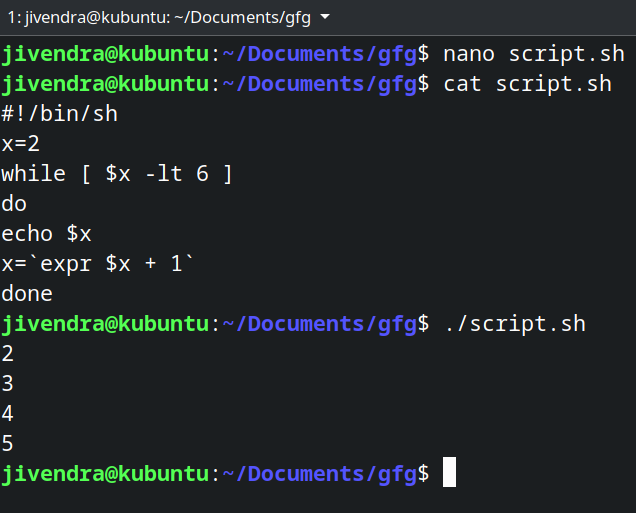
While loop
We enclose an expr statement within ` ` when assigning information technology to a variable. You can read about expr control here.
For loop
In a for loop, the variable iterates over a list of values and ends when at that place are no more values to iterate over.
Syntax
for var in val1 val2 val3 do #statements done
Allow'southward see an example.
#!/bin/sh for var in two 4 5 8 practise echo $var done
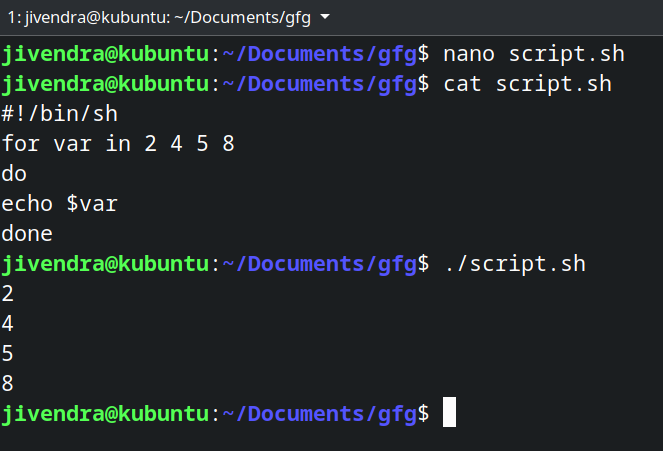
for loop
You lot can read about loops in detail here.
Positional Arguments
Positional arguments are the arguments or values which we pass to the shell script while executing the script. They are accessed by variables $0, $1, $two … $9. Beyond that, they are referenced by ${ten}, ${11} and and then on. $# stores the no of passed arguments and $0 stores the name of the script. Let'south see an case to understand all this.
#!/bin/sh echo "No of arguments is $#" echo "Name of the script is $0" echo "First argument is $ane" echo "Second argument is $2"
To pass the arguments, just type them in the terminal after the script name equally shown below.
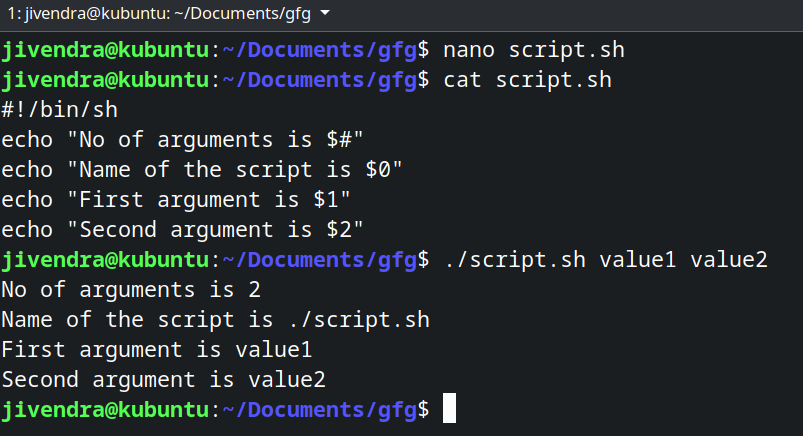
Positional Arguments
Storing the output of commands
Yous can shop the output of commands inside a variable in a shell script. There are two means to do then.
Syntax
#Syntax 1 var=$(a valid linux command) #Syntax 2 var2=`a valid linux command`
Let'south run across an instance.
#!/bin/sh b=$(pwd) c=`pwd` repeat $b echo $c d=$(ls /bin | grep bash) echo $d
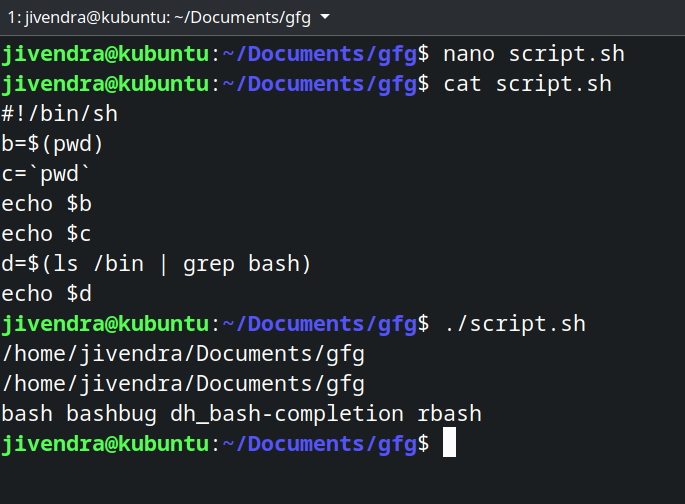
Storing the output of commands
Go out Codes of trounce commands
Whenever a command ends and returns the command to the parent process, information technology returns exit codes between 0 and 255. Exit code 0 means the command was successful, and any other leave code ways, the command was unsuccessful. Yous can view the leave code afterwards running any control by accessing the #? variable. See the instance below.

exit code of crush command
You can manually set an leave code for your shell script. This can exist used with conditional statements to convey if the script's purpose was achieved or not.
Example
#!/bin/sh read x if [ $x -ne 10 ] then echo failed leave ane else echo passed get out 0 fi
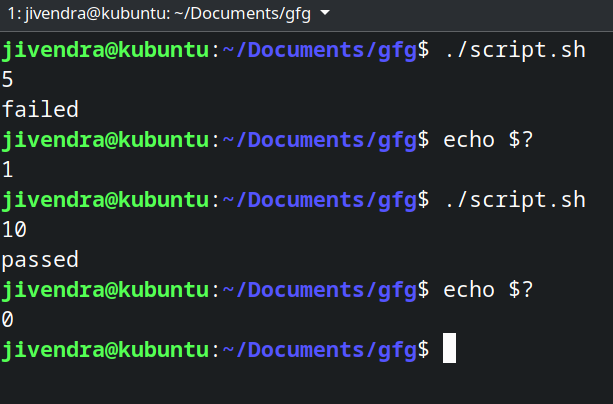
go out code of shell command
Source: https://www.geeksforgeeks.org/how-to-create-a-shell-script-in-linux/
Posted by: fosterwhippyraton.blogspot.com

0 Response to "How To Create A Shell Script In Windows"
Post a Comment